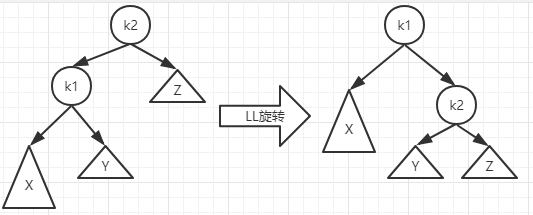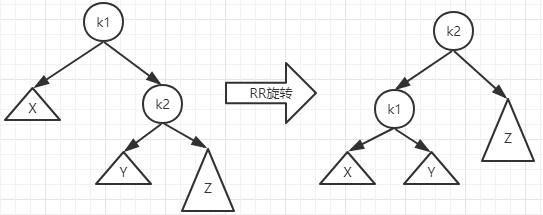Java数据结构与算法(5):AVL树
AVL树是带有平衡条件的二叉查找树,它是每个节点的左子树和右子树的高度最多差1的二叉查找树。AVL树的节点定义如下:
class AVLNode<T> {
T element; // 键值
int height; // 高度
AVLNode<T> left;
AVLNode<T> right;
AVLNode(T element) {
this(element, null, null);
}
AVLNode(T element, AVLNode<T> left, AVLNode<T> right) {
this.element = element;
this.height = 0;
this.left = left;
this.right = right;
}
}
根据AVL树的性质,当插入新的节点时,可能破坏平衡性质,因此需要对树进行旋转来满足平衡条件。AVL树的不平衡可以总结为4种情形:LL、RR、LR、RL,由于对称性,逻辑上可以认为两种。
单旋转
LL型

如图,当子树X插入新节点后,节点k2不满足AVL的平衡条件。为了使树恢复平衡,我们可以抽象地将树看成是柔和的,抓住k1节点使劲摇动它,在重力的作用下k1变成了新的根,k2变成了k1的右儿子,X和Z分别是k1的左儿子和k2的右儿子。子树Y介于k1和k2之间的那些节点,可以将它作为k2的左儿子,这样一棵新的AVL树诞生了。k1的高度取决于k1左子树X的高度和k1右子树k2的高度,k2的高度取决于k2的左子树Y和k2的右子树Z的高度。
LL旋转方法:
private AVLNode<T> leftLeftRotation(AVLNode<T> k2) {
AVLNode<T> k1 = k2.left;
k2.left = k1.right;
k1.right = k2;
k2.height = max(height(k2.left), height(k2.right)) + 1;
k1.height = max(height(k1.left), k2.height) + 1;
return k1;
}
RR型

理解了上面的LL型旋转就不难理解RR型的旋转了,根据对称性,RR型也只需要通过一次单旋转就可以完成。
private AVLNode<T> rightRightRotation(AVLNode<T> k1) {
AVLNode<T> k2 = k1.right;
k1.right = k2.left;
k2.left = k1;
k1.height = max(height(k1.left), height(k1.right)) + 1;
k2.height = max(height(k2.right), k1.height) + 1;
return k2;
}
双旋转
LR型

对于上图第一棵树描述的情形,由于以k2为父节点的子树为太深,这时候如果以k1为根节点,经过一次旋转后它就变成了RL型,依然不符合AVL树的平衡条件,因此,我们先忽略掉k3和D,左子树是一棵以k1为根节点的RR型二叉树,首先进行一次RR旋转,接着这就是一棵LL型树了,再次进行一次LL旋转,AVL树就生成了。
LR型旋转方式:
private AVLNode<T> leftRightRotation(AVLNode<T> k3) {
k3.left = rightRightRotation(k3.left);
return leftLeftRotation(k3);
}
RL型

根据对称性,理解RL型旋转应该不是一件很难的事了。RL型旋转方式:
private AVLNode<T> rightLeftRotation(AVLNode<T> k1) {
k1.right = leftLeftRotation(k1.right);
return rightRightRotation(k1);
}
插入
向一棵AVL树中插入新的节点时,我们的做法与二叉树查找树的思想是一样的,不同的是AVL树在插入新的节点后需要再执行一次平衡操作,如果树高度不平衡,需要进行单旋转或双旋转。
private AVLNode<T> insert(T x, AVLNode<T> t) {
if (t == null) {
return new AVLNode<>(x, null, null);
}
int cmp = x.compareTo(t.element);
if (cmp < 0) {
t.left = insert(x, t.left);
} else if (cmp > 0) {
t.right = insert(x, t.right);
} else {
// 重复值不处理
}
return balance(t);
}
balance方法:
private static final int ALLOWED_IMBALANCE = 1;
private AVLNode<T> balance(AVLNode<T> t) {
if (t == null) {
return t;
}
// 左儿子的高度大于右儿子的高度
if (height(t.left) - height(t.right) > ALLOWED_IMBALANCE) {
if (height(t.left.left) >= height(t.left.right)) {
// LL型-左儿子的左儿子高度大于左儿子的右儿子高度
t = leftLeftRotation(t);
} else {
// LR型-左儿子的右儿子高度大于左儿子的左儿子高度
t = leftRightRotation(t);
}
} else if (height(t.right) - height(t.left) > ALLOWED_IMBALANCE) {
// 右儿子高度大于左儿子高度
if (height(t.right.right) >= height(t.right.left)) {
// RR型-右儿子的右儿子高度大于右儿子的左儿子高度
t = rightRightRotation(t);
} else {
// RL型-右儿子的左儿子高度大于右儿子的右儿子高度
t = rightLeftRotation(t);
}
}
t.height = Math.max(height(t.left), height(t.right)) + 1;
return t;
}
删除
理解了插入操作,我们不难了解删除操作,就是在二叉查找树的删除基础上,在最后添加平衡操作。
private AVLNode<T> remove(T x, AVLNode<T> t) {
if (t == null) {
return t;
}
int cmp = x.compareTo(t.element);
if (cmp < 0) {
t.left = remove(x, t.left);
} else if (cmp > 0) {
t.right = remove(x, t.right);
} else if (t.left != null && t.right != null) {
t.element = findMin(t.right).element;
t.right = remove(t.element, t.right);
} else {
t = (t.left != null) ? t.left : t.right;
}
return balance(t);
}
AVL树的完成编码:
class AVLTree<T extends Comparable<T>> {
private AVLNode<T> root;
private int height(AVLNode<T> tree) {
if (tree != null) {
return tree.height;
}
return 0;
}
public int height() {
return root.height;
}
public AVLNode<T> search(T element) {
return search(root, element);
}
private AVLNode<T> search(AVLNode<T> x, T element) {
if (x == null) {
return x;
}
int cmp = element.compareTo(x.element);
if (cmp < 0) {
return search(x.left, element);
} else if (cmp > 0) {
return search(x.right, element);
} else {
return x;
}
}
public AVLNode<T> insert(T x) {
return insert(x, root);
}
private AVLNode<T> insert(T x, AVLNode<T> t) {
if (t == null) {
return new AVLNode<>(x, null, null);
}
int cmp = x.compareTo(t.element);
if (cmp < 0) {
t.left = insert(x, t.left);
} else if (cmp > 0) {
t.right = insert(x, t.right);
} else {
// 重复值不处理
}
return balance(t);
}
public AVLNode<T> remove(T x) {
return remove(x, root);
}
private AVLNode<T> remove(T x, AVLNode<T> t) {
if (t == null) {
return t;
}
int cmp = x.compareTo(t.element);
if (cmp < 0) {
t.left = remove(x, t.left);
} else if (cmp > 0) {
t.right = remove(x, t.right);
} else if (t.left != null && t.right != null) {
t.element = findMin(t.right).element;
t.right = remove(t.element, t.right);
} else {
t = (t.left != null) ? t.left : t.right;
}
return balance(t);
}
public AVLNode<T> findMax() {
return findMax(root);
}
private AVLNode<T> findMax(AVLNode<T> x) {
if (x == null) {
return x;
}
while (x.right != null) {
x = x.right;
}
return x;
}
public AVLNode<T> findMin() {
return findMin(root);
}
private AVLNode<T> findMin(AVLNode<T> x) {
if (x == null) {
return x;
}
while (x.left != null) {
x = x.left;
}
return x;
}
private AVLNode<T> leftLeftRotation(AVLNode<T> k2) {
AVLNode<T> k1 = k2.left;
k2.left = k1.right;
k1.right = k2;
k2.height = max(height(k2.left), height(k2.right)) + 1;
k1.height = max(height(k1.left), k2.height) + 1;
return k1;
}
private AVLNode<T> rightRightRotation(AVLNode<T> k1) {
AVLNode<T> k2 = k1.right;
k1.right = k2.left;
k2.left = k1;
k1.height = max(height(k1.left), height(k1.right)) + 1;
k2.height = max(height(k2.right), k1.height) + 1;
return k2;
}
private AVLNode<T> leftRightRotation(AVLNode<T> k3) {
k3.left = rightRightRotation(k3.left);
return leftLeftRotation(k3);
}
private AVLNode<T> rightLeftRotation(AVLNode<T> k1) {
k1.right = leftLeftRotation(k1.right);
return rightRightRotation(k1);
}
private int max(int a, int b) {
return a > b ? a : b;
}
private static final int ALLOWED_IMBALANCE = 1;
private AVLNode<T> balance(AVLNode<T> t) {
if (t == null) {
return t;
}
if (height(t.left) - height(t.right) > ALLOWED_IMBALANCE) {
if (height(t.left.left) >= height(t.left.right)) {
// LL型
t = leftLeftRotation(t);
} else {
// LR型
t = leftRightRotation(t);
}
} else if (height(t.right) - height(t.left) > ALLOWED_IMBALANCE) {
if (height(t.right.right) >= height(t.right.left)) {
// RR型
t = rightRightRotation(t);
} else {
// RL型
t = rightLeftRotation(t);
}
}
t.height = Math.max(height(t.left), height(t.right)) + 1;
return t;
}
private static class AVLNode<T> {
T element; // 键值
int height; // 高度
AVLNode<T> left;
AVLNode<T> right;
public AVLNode(T element, AVLNode<T> left, AVLNode<T> right) {
this.element = element;
this.height = 0;
this.left = left;
this.right = right;
}
}
}


